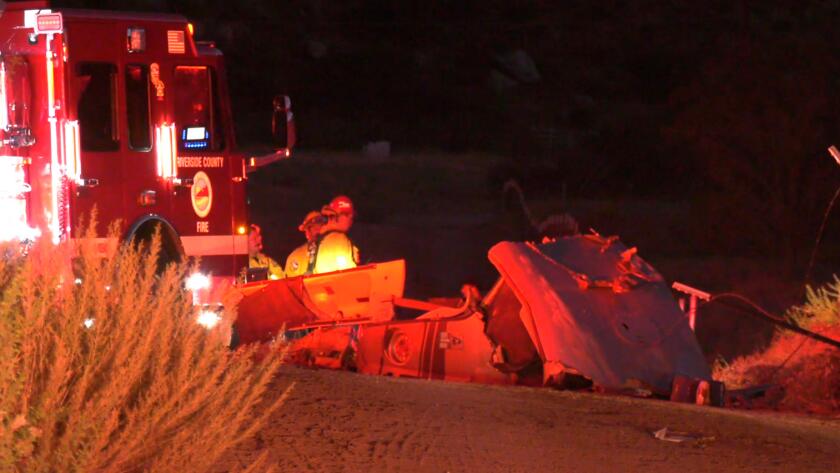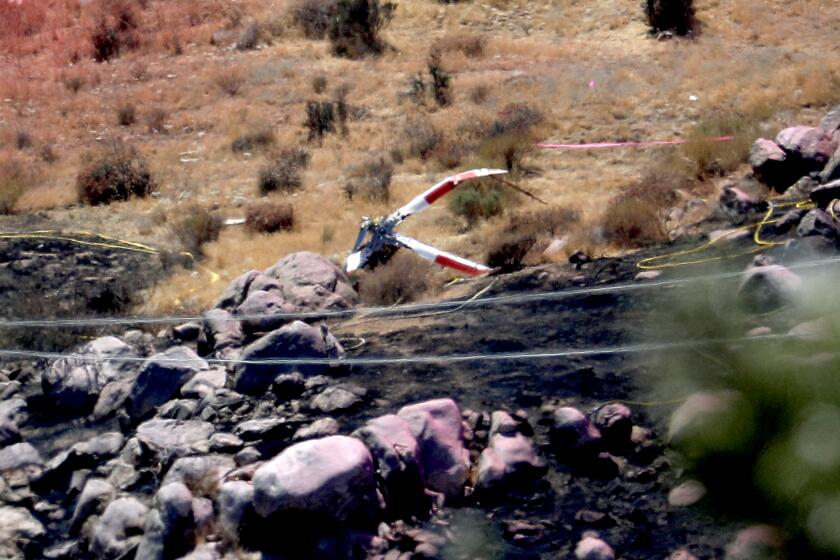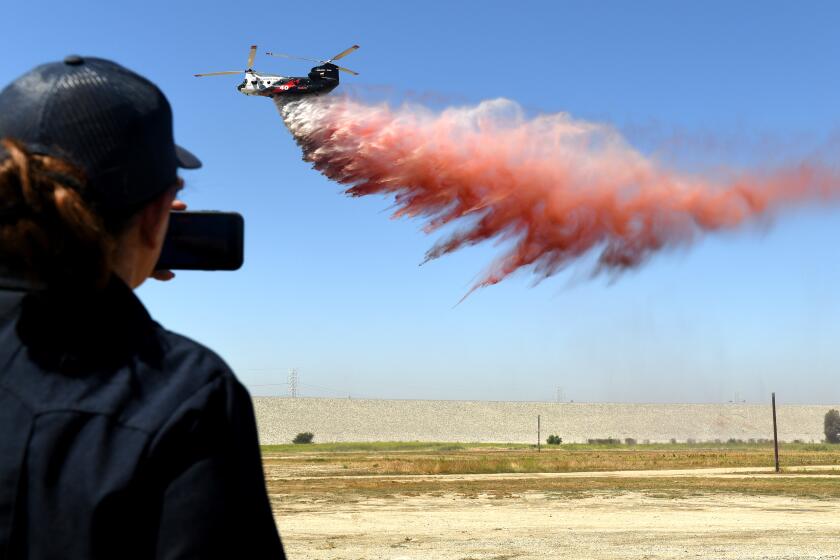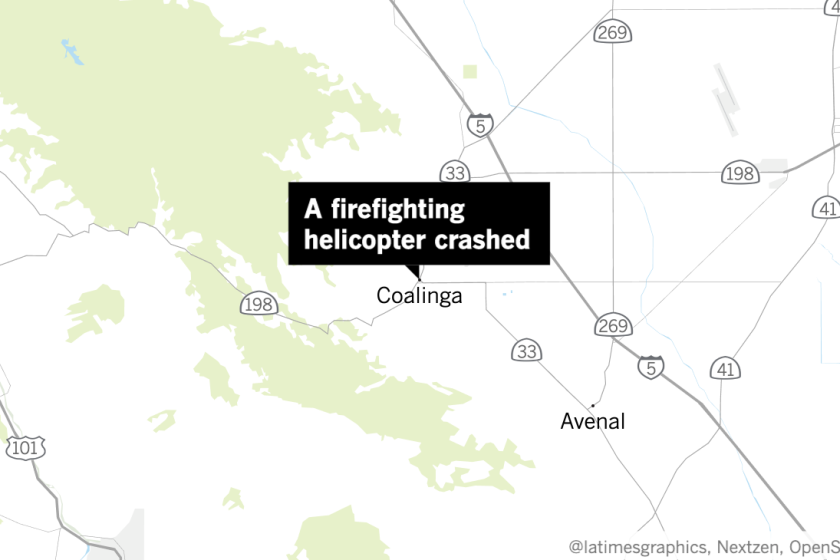Authorities investigate Cabazon helicopter crash that killed 3: ‘This should never happen’
- Share via
Firefighters were battling a small fire in the Cabazon area when two helicopters collided and one plunged to the ground. The other landed safely.
- Share via
CABAZON, Calif. — A spray of pink retardant marked a rocky hillside in Riverside County on Monday where, only hours earlier, two firefighting helicopters were involved in a rare and fatal collision while battling a small blaze — and it could be years before officials determine how it happened.
The tragedy in the skies over Cabazon left three people dead and authorities scrambling to discern what could have gone wrong. The two choppers struck each other at 6:55 p.m. Sunday, with one crashing and the other landing safely.
“This is clearly a failure of command and control to have two airplanes in the vicinity of the fire at the same time,” said Robert Ditchey, an aviation expert who reviewed the incident. “Somebody really screwed up.”
The three people killed in the crash were identified as California Department of Forestry and Fire Protection Assistant Chief Joshua Bischof, 46, Cal Fire Capt. Tim Rodriguez, 44, and contract pilot Tony Sousa, 55.
The aircraft that crashed was a Bell 407 helicopter that was responsible for observation and coordination, officials said. The second helicopter — a Sikorsky S-64E, also called a Skycrane — was able to make a safe landing with two people on board.
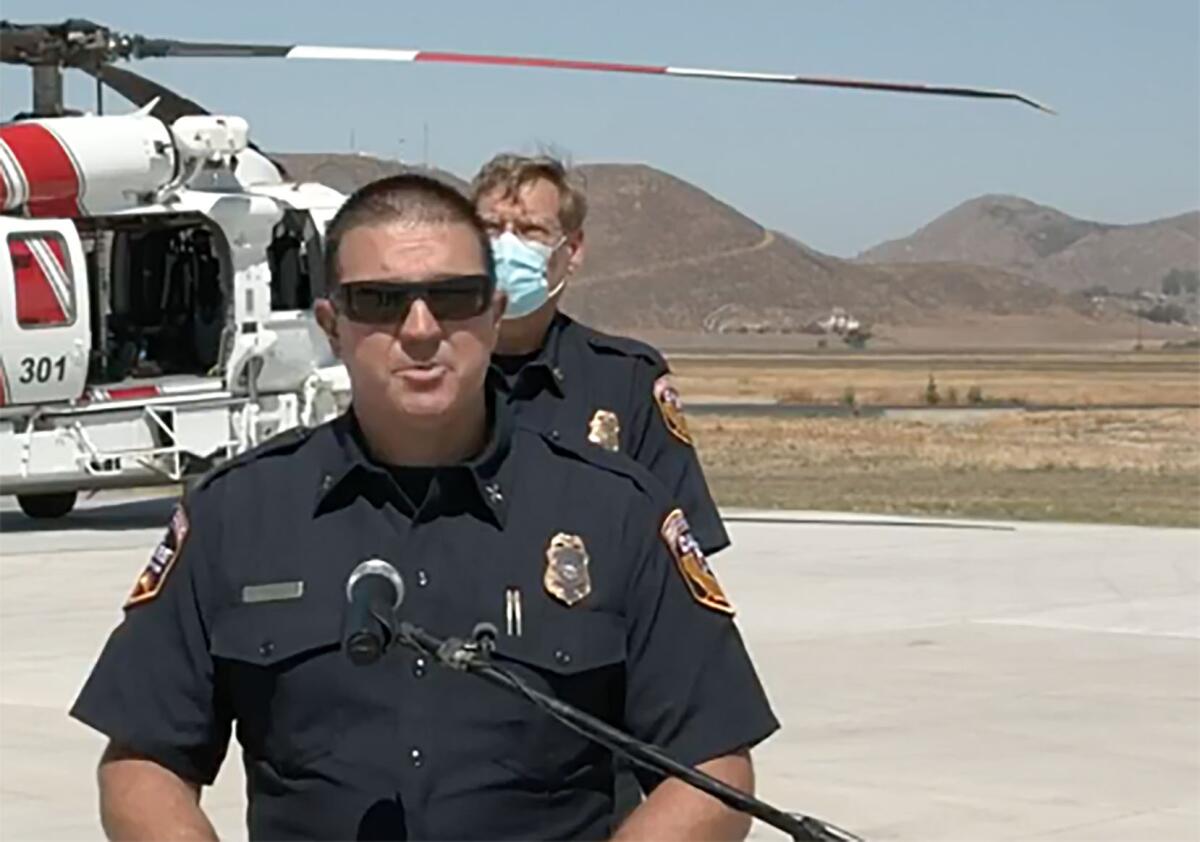
Although firefighting aircraft have been involved in crashes in the past, experts say the midair collision of two helicopters is highly unusual.
Investigators with the National Transportation Safety Board arrived Monday afternoon to document evidence at the scene and examine the aircraft. The investigation also will examine radar data, weather, maintenance records and the pilot’s medical records, spokesperson Jennifer Gabris said.
Eleazar Nepomuceno, an aviation accident investigator with the NTSB, said the full investigation could take up to two years to complete, at the end of which the board would issue its final determination on the cause of the collision.
Nepomuceno was part of the investigation team dispatched to Cabazon on Monday. Others involved included an FAA official and representatives for the manufacturers and companies that operated the helicopters.
“Our plan,” he said, “is to document the wreckage before relocating [it] to a secure facility in Arizona.”
Nepomuceno said investigators had gathered witness reports of the crash but asked anyone else who might have witnessed the incident to contact them by emailing [email protected].
After the wreckage is recovered, Nepomuceno said investigators would look at the certifications held by the pilots, their flight training history, the components of the aircraft — such as the airframe and engine — and the weather conditions during the crash.
“At this early stage of an investigation, NTSB does not state a cause but will provide factual information when available,” Gabris said. A preliminary report is likely within 15 business days.
Nick Schuler, deputy director of communications and emergency incident awareness with Cal Fire, said he “couldn’t even begin to speculate what caused [the collision] to occur.”
The men were part of a group battling a small blaze in Riverside when their chopper struck another helicopter in midair around 7:05 p.m. Sunday.
Debris was still smoldering in a yard on nearby Broadway on Monday afternoon. A patch of trees had blackened trunks, and retardant stained a wash next to the home.
Battalion Chief Isaac Sanchez said the Bell had been serving as a helicopter coordinator.
“What that means is we’ll try to spread the workload around. We’ll bring additional resources in order to alleviate some of the pressure on the air tactical supervisor,” he said. “And so in this case they are there to deal directly with the helicopters that are on the fire, and then report to and take direction from the air tactical supervisor.”
But aircraft usually follow very prescribed paths that are set by incident commanders on the ground, said Ditchey, the aviation expert. It was likely that the Bell chopper was not in the proper position, he said.
“I’m guessing that the pilot of the Sikorsky Skycrane was focused on the fire to make the run in. He or she was not looking for any other aircraft in the area because that’s normally a highly coordinated thing,” he said. “You wouldn’t expect the Sikorsky to be looking around to see if there’s another airplane on that very critical path.”
He said, however, he did not think the pilots were to blame.
“This should never happen because nobody should be there without the specific approval of the fire control chief,” Ditchey said. “This is a command-and-control problem, in my opinion.”
For that reason, the NTSB and Federal Aviation Administration investigations will probably focus on the ground command, he said. He added that visibility did not seem to be an issue as the crash happened during daylight hours in apparently clear conditions, and mechanical failure did not seem likely.
Skies were mostly clear Sunday evening, with no visibility restrictions around the time of the crash, the National Weather Service said Monday. Winds were blowing out of the south and southwest about 15 to 20 mph. Sanchez said it was unclear, however, whether smoke from the fire might have affected visibilty.
The Quick Reaction Force from the Los Angeles, Ventura and Orange county fire departments will be available 24 hours a day all year long.
The crash occurred not long after Cal Fire and the Riverside County Fire Department were dispatched to a reported structure fire around 6 p.m. Sunday near Broadway Street and Esperanza Avenue in Cabazon, according to David Fulcher, Cal Fire’s southern region chief.
A full wildland fire response team, including fixed- and rotary-wing aircraft, was dispatched to the scene because the fire — dubbed the Broadway fire — was reported to have spread to vegetation, Fulcher said.
The crash ignited a separate 4-acre blaze, called the Bonita fire, which was extinguished, Fulcher said. He did not elaborate on the type of fuel that caught fire but described it as “the typical grass and vegetation in the Cabazon area.”
Although such a robust response to a wildfire is not uncommon, Ditchey said the number of aircraft seemed like a lot for a small blaze, and it may reflect a heightened concern about what was in the fire’s path. Satellite imagery of the area shows a skate park, an elementary school and nearby homes.
A firefighting helicopter crashed in Fresno County on Wednesday, killing the pilot and briefly sparking another brush fire to join the dozens burning across the state.
Officials said the helicopters involved were among 24 exclusive aircraft secured by Gov. Gavin Newsom this year to help bolster Cal Fire’s fleet. The aircraft were contracted for a period of 90 to 120 days.
“These aircraft have been strategically located in communities across California and will be pre-positioned to meet the needs of potential fire activity throughout the state,” the agency said in a July 1 news release about the program, which was funded as part of a $72-million investment from the governor to enhance firefighting response.
Cal Fire has the largest civil aerial firefighting fleet in the world, including more than 60 fixed- and rotary-wing aircraft.
In a statement Monday, Newsom said flags at the state Capitol would be flown at half-staff in honor of the victims.
“On behalf of all Californians, our thoughts and heartfelt sympathies are with the loved ones, friends and Cal Fire colleagues mourning the loss of Assistant Chief Bischof, Fire Captain Rodriguez and Pilot Sousa,” Newsom said. “This terrible tragedy is a reminder of the dangers our courageous firefighters face daily while working to keep our communities safe. We owe them our deepest respect and gratitude and will always honor their bravery and sacrifices.”
Bischof, who was only recently promoted to assistant fire chief in Riverside County, had spent years in planes and helicopters directing aerial attacks of fires. He routinely posted photos from high above blazes.
Rodriguez was a fire captain with Hemet Ryan Air Attack Base. He had a wife and children, according to a family member who asked not to be identified.
“His life was firefighting,” the family member said. “He loved doing it, and he loved training and training people.”
Fewer details were known about Sousa, but a union known as Storey County Professional Fire Fighters posted on Facebook that he was among the victims.
“Everyone in the fire service knows the dangers, but all accept the risk, as we all want to help others in their time of need,” the post said.
Firefighters were battling a small fire in the Cabazon area when two helicopters collided, one of which plunged to earth. The other landed safely.
Sanchez, the battalion chief, said all members of the department were grappling with the loss.
“So is it difficult? Absolutely. And this is having repercussions not only locally for the fire industry in the Riverside County area but across the entire state. This is something that nobody wants to have to deal with.”
Schuler, of Cal Fire, said the agency dropped more than 15 million gallons of water and 9 million gallons of retardant over wildfires in 2022.
“This is something we do every single day, and our pilots are highly proficient,” he said. “Our folks are world-renowned aviators. Obviously, it’s a tragic loss.”
In 2014, a Cal Fire air tanker crashed while battling the Dog Rock fire near Yosemite National Park, killing the pilot. In 2008, a Sikorsky firefighting helicopter operated by the U.S. Forest Service collided with trees and terrain during takeoff near Weaverville, killing nine and seriously injuring four others.
In 2020, the pilot of a UH-1 helicopter died on a water-dropping mission while battling the 1,500-acre Hills fire in Fresno County. And in 2022, a helicopter assisting with firefighting operations in the Fairview fire near Hemet crashed while attempting to land at the Banning Airport, injuring the pilot and two others.
But Schuler said he could not recall any similar incidents involving two aircraft colliding.
“It’s so, so rare that these things occur,” he said.
Times staff writer Jeremy Childs contributed to this report.
More to Read
Sign up for Essential California
The most important California stories and recommendations in your inbox every morning.
You may occasionally receive promotional content from the Los Angeles Times.
